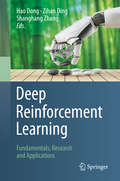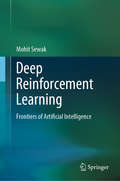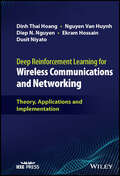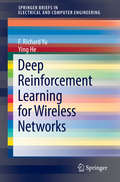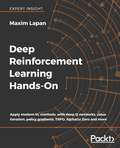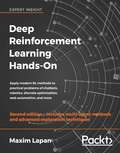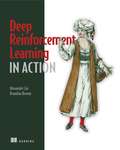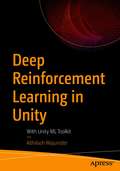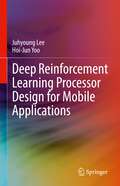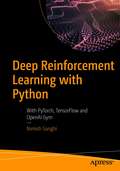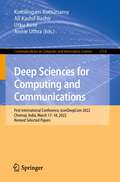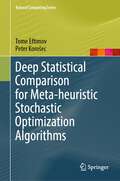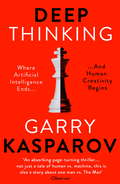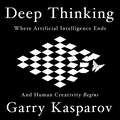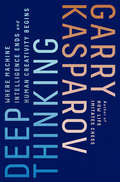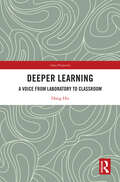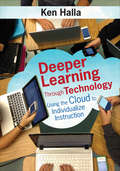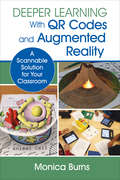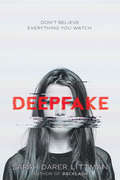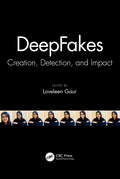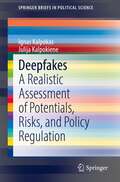- Table View
- List View
Deep Reinforcement Learning: Fundamentals, Research and Applications
by Hao Dong Zihan Ding Shanghang ZhangDeep reinforcement learning (DRL) is the combination of reinforcement learning (RL) and deep learning. It has been able to solve a wide range of complex decision-making tasks that were previously out of reach for a machine, and famously contributed to the success of AlphaGo. Furthermore, it opens up numerous new applications in domains such as healthcare, robotics, smart grids and finance. Divided into three main parts, this book provides a comprehensive and self-contained introduction to DRL. The first part introduces the foundations of deep learning, reinforcement learning (RL) and widely used deep RL methods and discusses their implementation. The second part covers selected DRL research topics, which are useful for those wanting to specialize in DRL research. To help readers gain a deep understanding of DRL and quickly apply the techniques in practice, the third part presents mass applications, such as the intelligent transportation system and learning to run, with detailed explanations. The book is intended for computer science students, both undergraduate and postgraduate, who would like to learn DRL from scratch, practice its implementation, and explore the research topics. It also appeals to engineers and practitioners who do not have strong machine learning background, but want to quickly understand how DRL works and use the techniques in their applications.
Deep Reinforcement Learning: Frontiers of Artificial Intelligence
by Mohit SewakThis book starts by presenting the basics of reinforcement learning using highly intuitive and easy-to-understand examples and applications, and then introduces the cutting-edge research advances that make reinforcement learning capable of out-performing most state-of-art systems, and even humans in a number of applications. The book not only equips readers with an understanding of multiple advanced and innovative algorithms, but also prepares them to implement systems such as those created by Google Deep Mind in actual code. This book is intended for readers who want to both understand and apply advanced concepts in a field that combines the best of two worlds – deep learning and reinforcement learning – to tap the potential of ‘advanced artificial intelligence’ for creating real-world applications and game-winning algorithms.
Deep Reinforcement Learning for Wireless Communications and Networking: Theory, Applications and Implementation
by Dinh Thai Hoang Nguyen Van Huynh Diep N. Nguyen Ekram Hossain Dusit NiyatoDeep Reinforcement Learning for Wireless Communications and Networking Comprehensive guide to Deep Reinforcement Learning (DRL) as applied to wireless communication systems Deep Reinforcement Learning for Wireless Communications and Networking presents an overview of the development of DRL while providing fundamental knowledge about theories, formulation, design, learning models, algorithms and implementation of DRL together with a particular case study to practice. The book also covers diverse applications of DRL to address various problems in wireless networks, such as caching, offloading, resource sharing, and security. The authors discuss open issues by introducing some advanced DRL approaches to address emerging issues in wireless communications and networking. Covering new advanced models of DRL, e.g., deep dueling architecture and generative adversarial networks, as well as emerging problems considered in wireless networks, e.g., ambient backscatter communication, intelligent reflecting surfaces and edge intelligence, this is the first comprehensive book studying applications of DRL for wireless networks that presents the state-of-the-art research in architecture, protocol, and application design. Deep Reinforcement Learning for Wireless Communications and Networking covers specific topics such as: Deep reinforcement learning models, covering deep learning, deep reinforcement learning, and models of deep reinforcement learning Physical layer applications covering signal detection, decoding, and beamforming, power and rate control, and physical-layer security Medium access control (MAC) layer applications, covering resource allocation, channel access, and user/cell association Network layer applications, covering traffic routing, network classification, and network slicing With comprehensive coverage of an exciting and noteworthy new technology, Deep Reinforcement Learning for Wireless Communications and Networking is an essential learning resource for researchers and communications engineers, along with developers and entrepreneurs in autonomous systems, who wish to harness this technology in practical applications.
Deep Reinforcement Learning for Wireless Networks (SpringerBriefs in Electrical and Computer Engineering)
by F. Richard Yu Ying HeThis Springerbrief presents a deep reinforcement learning approach to wireless systems to improve system performance. Particularly, deep reinforcement learning approach is used in cache-enabled opportunistic interference alignment wireless networks and mobile social networks. Simulation results with different network parameters are presented to show the effectiveness of the proposed scheme. There is a phenomenal burst of research activities in artificial intelligence, deep reinforcement learning and wireless systems. Deep reinforcement learning has been successfully used to solve many practical problems. For example, Google DeepMind adopts this method on several artificial intelligent projects with big data (e.g., AlphaGo), and gets quite good results.. Graduate students in electrical and computer engineering, as well as computer science will find this brief useful as a study guide. Researchers, engineers, computer scientists, programmers, and policy makers will also find this brief to be a useful tool.
Deep Reinforcement Learning Hands-On: Apply modern RL methods, with deep Q-networks, value iteration, policy gradients, TRPO, AlphaGo Zero and more
by Maxim LapanThis practical guide will teach you how deep learning (DL) can be used to solve complex real-world problems. Key Features Explore deep reinforcement learning (RL), from the first principles to the latest algorithms Evaluate high-profile RL methods, including value iteration, deep Q-networks, policy gradients, TRPO, PPO, DDPG, D4PG, evolution strategies and genetic algorithms Keep up with the very latest industry developments, including AI-driven chatbotsBook DescriptionRecent developments in reinforcement learning (RL), combined with deep learning (DL), have seen unprecedented progress made towards training agents to solve complex problems in a human-like way. Google’s use of algorithms to play and defeat the well-known Atari arcade games has propelled the field to prominence, and researchers are generating new ideas at a rapid pace. Deep Reinforcement Learning Hands-On is a comprehensive guide to the very latest DL tools and their limitations. You will evaluate methods including Cross-entropy and policy gradients, before applying them to real-world environments. Take on both the Atari set of virtual games and family favorites such as Connect4. The book provides an introduction to the basics of RL, giving you the know-how to code intelligent learning agents to take on a formidable array of practical tasks. Discover how to implement Q-learning on ‘grid world’ environments, teach your agent to buy and trade stocks, and find out how natural language models are driving the boom in chatbots.What you will learn Understand the DL context of RL and implement complex DL models Learn the foundation of RL: Markov decision processes Evaluate RL methods including Cross-entropy, DQN, Actor-Critic, TRPO, PPO, DDPG, D4PG and others Discover how to deal with discrete and continuous action spaces in various environments Defeat Atari arcade games using the value iteration method Create your own OpenAI Gym environment to train a stock trading agent Teach your agent to play Connect4 using AlphaGo Zero Explore the very latest deep RL research on topics including AI-driven chatbotsWho this book is forSome fluency in Python is assumed. Basic deep learning (DL) approaches should be familiar to readers and some practical experience in DL will be helpful. This book is an introduction to deep reinforcement learning (RL) and requires no background in RL.
Deep Reinforcement Learning Hands-On: Apply modern RL methods to practical problems of chatbots, robotics, discrete optimization, web automation, and more, 2nd Edition
by Maxim LapanNew edition of the bestselling guide to deep reinforcement learning and how it's used to solve complex real-world problems. Revised and expanded to include multi-agent methods, discrete optimization, RL in robotics, advanced exploration techniques, and more Key Features Second edition of the bestselling introduction to deep reinforcement learning, expanded with six new chapters Learn advanced exploration techniques including noisy networks, pseudo-count, and network distillation methods Apply RL methods to cheap hardware robotics platforms Book Description Deep Reinforcement Learning Hands-On, Second Edition is an updated and expanded version of the bestselling guide to the very latest reinforcement learning (RL) tools and techniques. It provides you with an introduction to the fundamentals of RL, along with the hands-on ability to code intelligent learning agents to perform a range of practical tasks. With six new chapters devoted to a variety of up-to-the-minute developments in RL, including discrete optimization (solving the Rubik's Cube), multi-agent methods, Microsoft's TextWorld environment, advanced exploration techniques, and more, you will come away from this book with a deep understanding of the latest innovations in this emerging field. In addition, you will gain actionable insights into such topic areas as deep Q-networks, policy gradient methods, continuous control problems, and highly scalable, non-gradient methods. You will also discover how to build a real hardware robot trained with RL for less than $100 and solve the Pong environment in just 30 minutes of training using step-by-step code optimization. In short, Deep Reinforcement Learning Hands-On, Second Edition, is your companion to navigating the exciting complexities of RL as it helps you attain experience and knowledge through real-world examples. What you will learn Understand the deep learning context of RL and implement complex deep learning models Evaluate RL methods including cross-entropy, DQN, actor-critic, TRPO, PPO, DDPG, D4PG, and others Build a practical hardware robot trained with RL methods for less than $100 Discover Microsoft's TextWorld environment, which is an interactive fiction games platform Use discrete optimization in RL to solve a Rubik's Cube Teach your agent to play Connect 4 using AlphaGo Zero Explore the very latest deep RL research on topics including AI chatbots Discover advanced exploration techniques, including noisy networks and network distillation techniques Who this book is for Some fluency in Python is assumed. Sound understanding of the fundamentals of deep learning will be helpful. This book is an introduction to deep RL and requires no background in RL
Deep Reinforcement Learning in Action
by Brandon Brown Alexander ZaiSummary Humans learn best from feedback—we are encouraged to take actions that lead to positive results while deterred by decisions with negative consequences. This reinforcement process can be applied to computer programs allowing them to solve more complex problems that classical programming cannot. Deep Reinforcement Learning in Action teaches you the fundamental concepts and terminology of deep reinforcement learning, along with the practical skills and techniques you&’ll need to implement it into your own projects. Purchase of the print book includes a free eBook in PDF, Kindle, and ePub formats from Manning Publications. About the technology Deep reinforcement learning AI systems rapidly adapt to new environments, a vast improvement over standard neural networks. A DRL agent learns like people do, taking in raw data such as sensor input and refining its responses and predictions through trial and error. About the book Deep Reinforcement Learning in Action teaches you how to program AI agents that adapt and improve based on direct feedback from their environment. In this example-rich tutorial, you&’ll master foundational and advanced DRL techniques by taking on interesting challenges like navigating a maze and playing video games. Along the way, you&’ll work with core algorithms, including deep Q-networks and policy gradients, along with industry-standard tools like PyTorch and OpenAI Gym. What's inside Building and training DRL networks The most popular DRL algorithms for learning and problem solving Evolutionary algorithms for curiosity and multi-agent learning All examples available as Jupyter Notebooks About the reader For readers with intermediate skills in Python and deep learning. About the author Alexander Zai is a machine learning engineer at Amazon AI. Brandon Brown is a machine learning and data analysis blogger. Table of Contents PART 1 - FOUNDATIONS 1. What is reinforcement learning? 2. Modeling reinforcement learning problems: Markov decision processes 3. Predicting the best states and actions: Deep Q-networks 4. Learning to pick the best policy: Policy gradient methods 5. Tackling more complex problems with actor-critic methods PART 2 - ABOVE AND BEYOND 6. Alternative optimization methods: Evolutionary algorithms 7. Distributional DQN: Getting the full story 8.Curiosity-driven exploration 9. Multi-agent reinforcement learning 10. Interpretable reinforcement learning: Attention and relational models 11. In conclusion: A review and roadmap
Deep Reinforcement Learning in Unity: With Unity ML Toolkit
by Abhilash MajumderGain an in-depth overview of reinforcement learning for autonomous agents in game development with Unity.This book starts with an introduction to state-based reinforcement learning algorithms involving Markov models, Bellman equations, and writing custom C# code with the aim of contrasting value and policy-based functions in reinforcement learning. Then, you will move on to path finding and navigation meshes in Unity, setting up the ML Agents Toolkit (including how to install and set up ML agents from the GitHub repository), and installing fundamental machine learning libraries and frameworks (such as Tensorflow). You will learn about: deep learning and work through an introduction to Tensorflow for writing neural networks (including perceptron, convolution, and LSTM networks), Q learning with Unity ML agents, and porting trained neural network models in Unity through the Python-C# API. You will also explore the OpenAI Gym Environment used throughout the book.Deep Reinforcement Learning in Unity provides a walk-through of the core fundamentals of deep reinforcement learning algorithms, especially variants of the value estimation, advantage, and policy gradient algorithms (including the differences between on and off policy algorithms in reinforcement learning). These core algorithms include actor critic, proximal policy, and deep deterministic policy gradients and its variants. And you will be able to write custom neural networks using the Tensorflow and Keras frameworks. Deep learning in games makes the agents learn how they can perform better and collect their rewards in adverse environments without user interference. The book provides a thorough overview of integrating ML Agents with Unity for deep reinforcement learning.What You Will Learn Understand how deep reinforcement learning works in gamesGrasp the fundamentals of deep reinforcement learning Integrate these fundamentals with the Unity ML Toolkit SDKGain insights into practical neural networks for training Agent Brain in the context of Unity ML AgentsCreate different models and perform hyper-parameter tuningUnderstand the Brain-Academy architecture in Unity ML AgentsUnderstand the Python-C# API interface during real-time training of neural networksGrasp the fundamentals of generic neural networks and their variants using TensorflowCreate simulations and visualize agents playing games in Unity Who This Book Is ForReaders with preliminary programming and game development experience in Unity, and those with experience in Python and a general idea of machine learning
Deep Reinforcement Learning Processor Design for Mobile Applications
by Juhyoung Lee Hoi-Jun YooThis book discusses the acceleration of deep reinforcement learning (DRL), which may be the next step in the burst success of artificial intelligence (AI). The authors address acceleration systems which enable DRL on area-limited & battery-limited mobile devices. Methods are described that enable DRL optimization at the algorithm-, architecture-, and circuit-levels of abstraction.
Deep Reinforcement Learning with Python: With PyTorch, TensorFlow and OpenAI Gym
by Nimish SanghiDeep reinforcement learning is a fast-growing discipline that is making a significant impact in fields of autonomous vehicles, robotics, healthcare, finance, and many more. This book covers deep reinforcement learning using deep-q learning and policy gradient models with coding exercise.You'll begin by reviewing the Markov decision processes, Bellman equations, and dynamic programming that form the core concepts and foundation of deep reinforcement learning. Next, you'll study model-free learning followed by function approximation using neural networks and deep learning. This is followed by various deep reinforcement learning algorithms such as deep q-networks, various flavors of actor-critic methods, and other policy-based methods. You'll also look at exploration vs exploitation dilemma, a key consideration in reinforcement learning algorithms, along with Monte Carlo tree search (MCTS), which played a key role in the success of AlphaGo. The final chapters conclude with deep reinforcement learning implementation using popular deep learning frameworks such as TensorFlow and PyTorch. In the end, you'll understand deep reinforcement learning along with deep q networks and policy gradient models implementation with TensorFlow, PyTorch, and Open AI Gym.What You'll LearnExamine deep reinforcement learning Implement deep learning algorithms using OpenAI’s Gym environmentCode your own game playing agents for Atari using actor-critic algorithmsApply best practices for model building and algorithm training Who This Book Is ForMachine learning developers and architects who want to stay ahead of the curve in the field of AI and deep learning.
Deep Sciences for Computing and Communications: First International Conference, IconDeepCom 2022, Chennai, India, March 17–18, 2022, Revised Selected Papers (Communications in Computer and Information Science #1719)
by Kottilingam Kottursamy Ali Kashif Bashir Utku Kose Annie UthraThis book constitutes selected papers presented during the First International Conference on Deep Sciences for Computing and Communications, IconDeepCom 2022, held in Chennai, India, in March 2022.The 27 papers presented were thoroughly reviewed and selected from 97 submissions. They are organized in topical sections as follows: classification and regression problems for communication paradigms; deep learning and vision computing; deep- recurrent neural network (RNN) for industrial informatics; extended AI for heterogeneous edge.
Deep Statistical Comparison for Meta-heuristic Stochastic Optimization Algorithms (Natural Computing Series)
by Tome Eftimov Peter KorošecFocusing on comprehensive comparisons of the performance of stochastic optimization algorithms, this book provides an overview of the current approaches used to analyze algorithm performance in a range of common scenarios, while also addressing issues that are often overlooked. In turn, it shows how these issues can be easily avoided by applying the principles that have produced Deep Statistical Comparison and its variants. The focus is on statistical analyses performed using single-objective and multi-objective optimization data. At the end of the book, examples from a recently developed web-service-based e-learning tool (DSCTool) are presented. The tool provides users with all the functionalities needed to make robust statistical comparison analyses in various statistical scenarios.The book is intended for newcomers to the field and experienced researchers alike. For newcomers, it covers the basics of optimization and statistical analysis, familiarizing them with the subject matter before introducing the Deep Statistical Comparison approach. Experienced researchers can quickly move on to the content on new statistical approaches. The book is divided into three parts:Part I: Introduction to optimization, benchmarking, and statistical analysis – Chapters 2-4.Part II: Deep Statistical Comparison of meta-heuristic stochastic optimization algorithms – Chapters 5-7.Part III: Implementation and application of Deep Statistical Comparison – Chapter 8.
Deep Thinking: Where Machine Intelligence Ends and Human Creativity Begins
by Garry KasparovIn May 1997, the world watched as Garry Kasparov, the greatest chess player in the world, was defeated for the first time by the IBM supercomputer Deep Blue. It was a watershed moment in the history of technology: machine intelligence had arrived at the point where it could best human intellect.It wasn't a coincidence that Kasparov became the symbol of man's fight against the machines. Chess has long been the fulcrum in development of machine intelligence; the hoax automaton 'The Turk' in the 18th century and Alan Turing's first chess program in 1952 were two early examples of the quest for machines to think like humans -- a talent we measured by their ability to beat their creators at chess. As the pre-eminent chessmaster of the 80s and 90s, it was Kasparov's blessing and his curse to play against each generation's strongest computer champions, contributing to their development and advancing the field. Like all passionate competitors, Kasparov has taken his defeat and learned from it. He has devoted much energy to devising ways in which humans can partner with machines in order to produce results better than either can achieve alone. During the twenty years since playing Deep Blue, he's played both with and against machines, learning a great deal about our vital relationship with our most remarkable creations. Ultimately, he's become convinced that by embracing the competition between human and machine intelligence, we can spend less time worrying about being replaced and more thinking of new challenges to conquer.In this breakthrough book, Kasparov tells his side of the story of Deep Blue for the first time -- what it was like to strategize against an implacable, untiring opponent -- the mistakes he made and the reasons the odds were against him. But more than that, he tells his story of AI more generally, and how he's evolved to embrace it, taking part in an urgent debate with philosophers worried about human values, programmers creating self-learning neural networks, and engineers of cutting edge robotics.
Deep Thinking: Where Machine Intelligence Ends and Human Creativity Begins
by Garry KasparovGarry Kasparov gives his first public account of his landmark 1997 chess match with the IBM supercomputer Deep Blue, and explains why, twenty years later, he's become convinced that artificial intelligence is good for humans.In May 1997, the world watched as Garry Kasparov, the greatest chess player in the world, was defeated for the first time by the IBM supercomputer Deep Blue. It was a watershed moment in the history of technology: machine intelligence had arrived at the point where it could best human intellect.It wasn't a coincidence that Kasparov became the symbol of man's fight against the machines. Chess has long been the fulcrum in development of machine intelligence; the hoax automaton 'The Turk' in the 18th century and Alan Turing's first chess program in 1952 were two early examples of the quest for machines to think like humans - a talent we measured by their ability to beat their creators at chess. As the pre-eminent chessmaster of the 80s and 90s, it was Kasparov's blessing and his curse to play against each generation's strongest computer champions, contributing to their development and advancing the field. Like all passionate competitors, Kasparov has taken his defeat and learned from it. He has devoted much energy to devising ways in which humans can partner with machines in order to produce results better than either can achieve alone. During the twenty years since playing Deep Blue, he's played both with and against machines, learning a great deal about our vital relationship with our most remarkable creations. Ultimately, he's become convinced that by embracing the competition between human and machine intelligence, we can spend less time worrying about being replaced and more thinking of new challenges to conquer.In this breakthrough book, Kasparov tells his side of the story of Deep Blue for the first time - what it was like to strategize against an implacable, untiring opponent - the mistakes he made and the reasons the odds were against him. But more than that, he tells his story of AI more generally, and how he's evolved to embrace it, taking part in an urgent debate with philosophers worried about human values, programmers creating self-learning neural networks, and engineers of cutting edge robotics.(P)2017 Hachette Audio
Deep Thinking: Where Machine Intelligence Ends and Human Creativity Begins
by Garry Kasparov Mig GreengardGarry Kasparov's 1997 chess match against the IBM supercomputer Deep Blue was a watershed moment in the history of technology. It was the dawn of a new era in artificial intelligence: a machine capable of beating the reigning human champion at this most cerebral game. That moment was more than a century in the making, and in this breakthrough book, Kasparov reveals his astonishing side of the story for the first time. He describes how it felt to strategize against an implacable, untiring opponent with the whole world watching, and recounts the history of machine intelligence through the microcosm of chess, considered by generations of scientific pioneers to be a key to unlocking the secrets of human and machine cognition. Kasparov uses his unrivaled experience to look into the future of intelligent machines and sees it bright with possibility. As many critics decry artificial intelligence as a menace, particularly to human jobs, Kasparov shows how humanity can rise to new heights with the help of our most extraordinary creations, rather than fear them. Deep Thinking is a tightly argued case for technological progress, from the man who stood at its precipice with his own career at stake.
Deeper Learning: A Voice from Laboratory to Classroom (China Perspectives)
by Hang HuIntegrating brain science, cognitive psychology, education and information technology, the books studies how technology promoted deeper learning on mathematics in Chinese primary schools. After introducing the theoretical basis, connotation and mechanism of deeper learning, the author fully explains its practice, including the composition of deeper learning teaching content, the development of digital resources, classroom teaching technology and teachers' professional development of deeper learning. He especially adopts multiple and interdisciplinary research methods, such as deeper learning "triangle evidence" paradigm, learning brain observation, education big data analysis, artificial intelligence education analysis, education action, qualitative and quantitative research. On one hand, the book will give researchers of learning theory and pedagogy an in-depth understanding of what deeper learning is and why it provides a systematic theoretical system; on the other hand, it will also provide school practitioners with operational methods and cases to learn from.
Deeper Learning Through Technology: Using the Cloud to Individualize Instruction
by Mr Kenneth P. HallaUse the Cloud to Individualize Your Instruction and Watch Your Students Thrive! Cloud-based technology offers massive benefits to the classroom. But technology tools require conscientious implementation by educators. This book is the all-in-one resource you need to be sure your students reap the fullest rewards of how cloud-based tools can facilitate learning. In Deeper Learning Through Technology, teacher and top ed-blogger Ken Halla explains: How to implement new tech tools to create a self-paced, learner-centered classroom Strategies for leveraging cloud technology to ensure that students have access to an individualized, personalized education Real-life case studies and activities that will make applying the book’s strategies to your classroom enjoyable and achievable
Deeper Learning Through Technology: Using the Cloud to Individualize Instruction
by Mr Kenneth P. HallaUse the Cloud to Individualize Your Instruction and Watch Your Students Thrive! Cloud-based technology offers massive benefits to the classroom. But technology tools require conscientious implementation by educators. This book is the all-in-one resource you need to be sure your students reap the fullest rewards of how cloud-based tools can facilitate learning. In Deeper Learning Through Technology, teacher and top ed-blogger Ken Halla explains: How to implement new tech tools to create a self-paced, learner-centered classroom Strategies for leveraging cloud technology to ensure that students have access to an individualized, personalized education Real-life case studies and activities that will make applying the book’s strategies to your classroom enjoyable and achievable
Deeper Learning Through Technology: Using the Cloud to Individualize Instruction
by Mr. Kenneth P. HallaUse the Cloud to Individualize Your Instruction and Watch Your Students Thrive! Cloud-based technology offers massive benefits to the classroom. But technology tools require conscientious implementation by educators. This book is the all-in-one resource you need to be sure your students reap the fullest rewards of how cloud-based tools can facilitate learning. In Deeper Learning Through Technology, teacher and top ed-blogger Ken Halla explains: How to implement new tech tools to create a self-paced, learner-centered classroom Strategies for leveraging cloud technology to ensure that students have access to an individualized, personalized education Real-life case studies and activities that will make applying the book’s strategies to your classroom enjoyable and achievable
Deeper Learning Through Technology: Using the Cloud to Individualize Instruction
by Mr. Kenneth P. HallaUse the Cloud to Individualize Your Instruction and Watch Your Students Thrive! Cloud-based technology offers massive benefits to the classroom. But technology tools require conscientious implementation by educators. This book is the all-in-one resource you need to be sure your students reap the fullest rewards of how cloud-based tools can facilitate learning. In Deeper Learning Through Technology, teacher and top ed-blogger Ken Halla explains: How to implement new tech tools to create a self-paced, learner-centered classroom Strategies for leveraging cloud technology to ensure that students have access to an individualized, personalized education Real-life case studies and activities that will make applying the book’s strategies to your classroom enjoyable and achievable
Deeper Learning With QR Codes and Augmented Reality: A Scannable Solution for Your Classroom (Corwin Teaching Essentials)
by Monica BurnsEngaging, interactive learning—right in your students’ hands! What if your students’ mobile devices became an instructional asset rather than a distraction? Discover how free, scannable technology can enrich learning, while captivating students. Best of all, these technologies are easy to quickly implement within your classroom. Learn about QR codes and Augmented Reality (AR) Reach each student with new, hands-on learning opportunities Embrace the ACES Framework for teaching with scannable technologies: Access, Curate, Engage, and Share Promote self-directed learning and showcase students’ creations Leverage technology to connect classroom activities with students’ families and the broader community
Deeper Learning With QR Codes and Augmented Reality: A Scannable Solution for Your Classroom (Corwin Teaching Essentials)
by Monica BurnsEngaging, interactive learning—right in your students’ hands! What if your students’ mobile devices became an instructional asset rather than a distraction? Discover how free, scannable technology can enrich learning, while captivating students. Best of all, these technologies are easy to quickly implement within your classroom. Learn about QR codes and Augmented Reality (AR) Reach each student with new, hands-on learning opportunities Embrace the ACES Framework for teaching with scannable technologies: Access, Curate, Engage, and Share Promote self-directed learning and showcase students’ creations Leverage technology to connect classroom activities with students’ families and the broader community
Deepfake
by Sarah Darer LittmanDara Simons and Will Halpern have everything they've ever wanted. They are the rulers of Greenpoint High's geekdom, overachieving in every way, and it's an intense competition to see who will be valedictorian. One the entire school is invested in. That is, until Rumor Has It, the anonymous gossip site, posts a video of Dara accusing Will of paying someone to take the SAT for him.When the video goes viral, suddenly Will's being investigated, and everyone's wondering how he pulled off cheating on the SAT. But Dara swears that she didn't say any of those things, which seems a little hard to believe since it's her in the video.Did Will cheat?Is it Dara saying he did?Who's lying, and who's telling the truth?The answer is more shocking than anyone realizes...
DeepFakes: Creation, Detection, and Impact
by Loveleen GaurDeepfakes is a synthetic media that leverage powerful Artificial Intelligence (AI) and machine learning (ML) techniques to generate fake visual and audio content that are extremely realistic, thus making it very hard for a human to distinguish from the original ones. Apart from technological introduction to the Deepfakes concept, the book details algorithms to detect Deepfakes, techniques for identifying manipulated content and identifying face swap, generative adversarial neural networks, media forensic techniques, deep learning architectures, forensic analysis of DeepFakes and so forth. Provides a technical introduction to DeepFakes, its benefits, and the potential harms Presents practical approaches of creation and detection of DeepFakes using Deep Learning (DL) Techniques Draws attention towards various challenging issues and societal impact of DeepFakes with their existing solutions Includes research analysis in the domain of DL fakes for assisting the creation and detection of DeepFakes applications Discusses future research directions with emergence of DeepFakes technology This book is aimed at graduate students, researchers and professionals in data science, artificial intelligence, computer vision, and machine learning.
Deepfakes: A Realistic Assessment of Potentials, Risks, and Policy Regulation (SpringerBriefs in Political Science)
by Ignas Kalpokas Julija KalpokieneThis book examines the use and potential impact of deepfakes, a type of synthetic computer-generated media, primarily images and videos, capable of both creating artificial representations of non-existent individuals and showing actual individuals doing things they did not do. As such, deepfakes pose an obvious threat of manipulation and, unsurprisingly, have been the subject of a great deal of alarmism in both the news media and academic articles. Hence, this book sets out to critically evaluate potential threats by analyzing human susceptibility to manipulation and using that as a backdrop for a discussion of actual and likely uses of deepfakes. In contrast to the usual threat narrative, this book will put forward a multi-sided picture of deepfakes, exploring their potential and that of adjacent technologies for creative use in domains ranging from film and advertisement to painting. The challenges posed by deepfakes are further evaluated with regard to present or forthcoming legislation and other regulatory measures. Finally, deepfakes are placed within a broader cultural and philosophical context, focusing primarily on posthumanist thought. Therefore, this book is a must-read for researchers, students, and practitioners of political science and other disciplines, interested in a better understanding of deepfakes.
